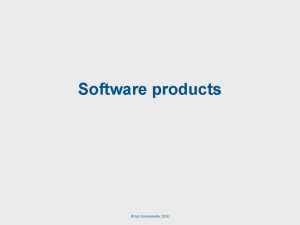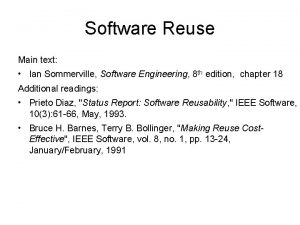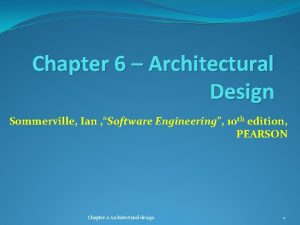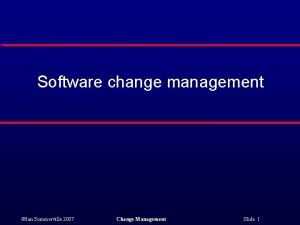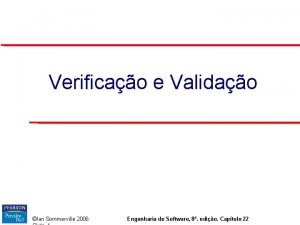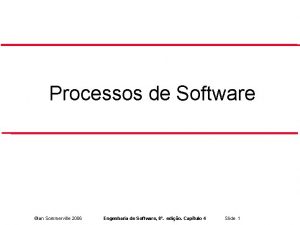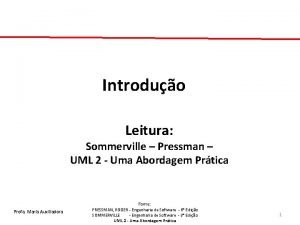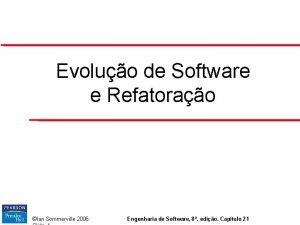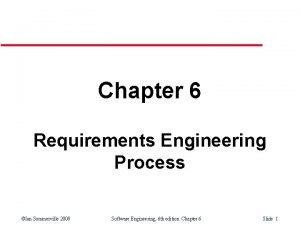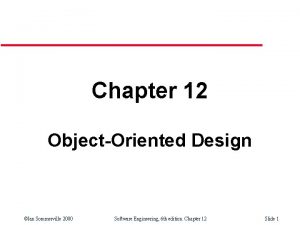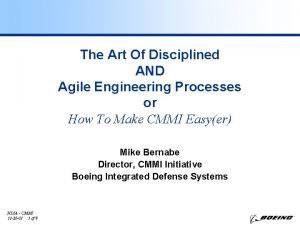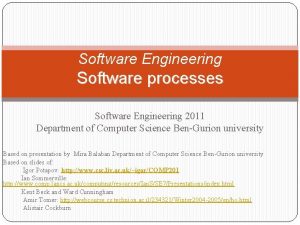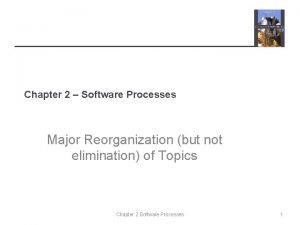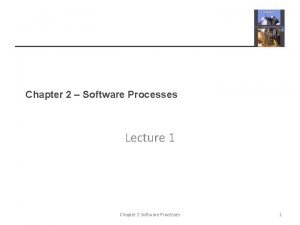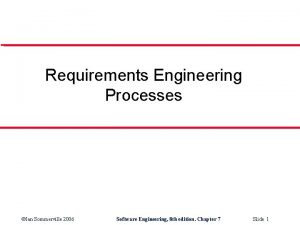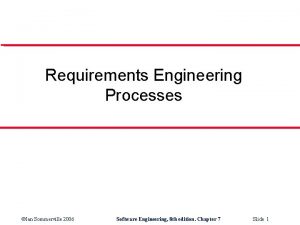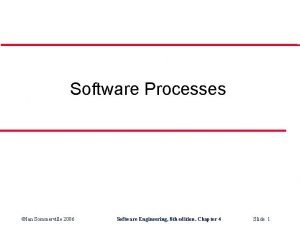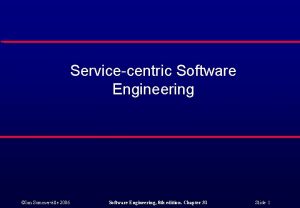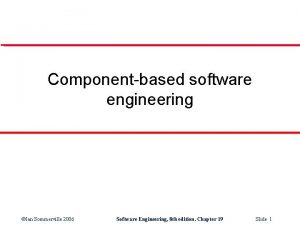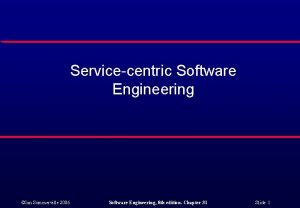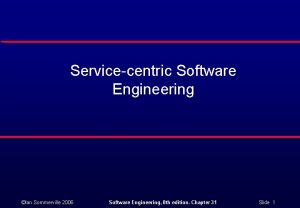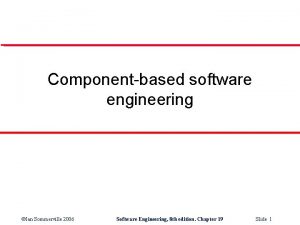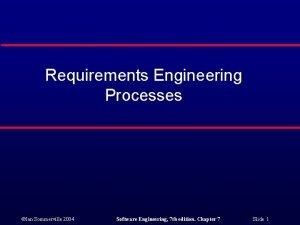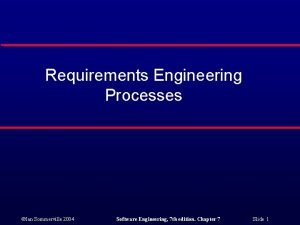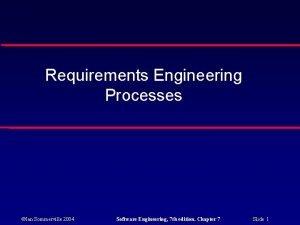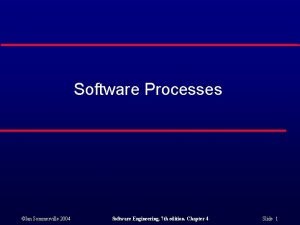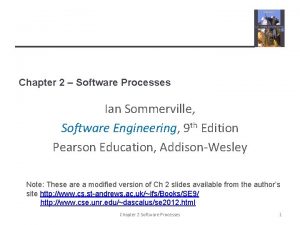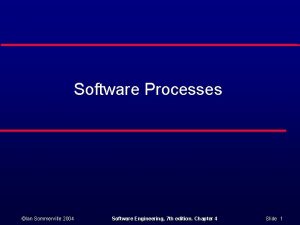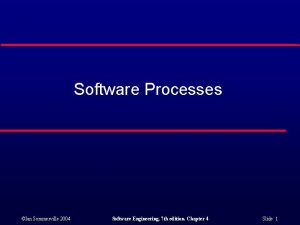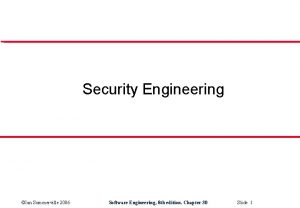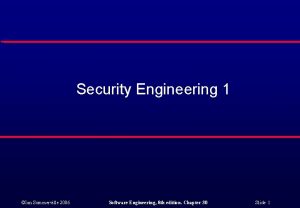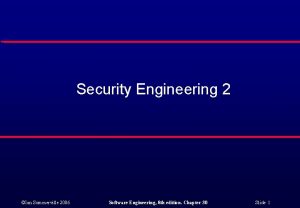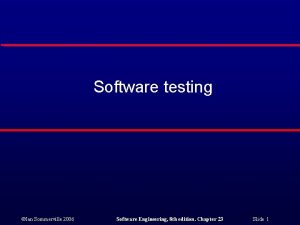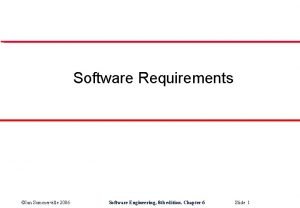Software Processes Ian Sommerville 2006 Software Engineering 8































- Slides: 31

Software Processes ©Ian Sommerville 2006 Software Engineering, 8 th edition. Chapter 4 Slide

The software process l l Software process: A structured set of activities required to develop a software system Fundamental activities which are common to all software activities: • • l l Specification; Design; Validation; Evolution. A software process model is an abstract representation of a process. It presents a description of a process from some particular perspective -> Each process model provides only partial information about that process. ©Ian Sommerville 2006 Software Engineering, 8 th edition. Chapter 4 Slide

Generic software process models l The waterfall model • l Evolutionary development • • • l l l Specification, development and validation are interleaved. An initial system is rapidly developed from abstract specifications. Then, refined with customer input. Component-based software engineering • l Seperates process phases such as requirements specifications, software design, implementation and testing. Based on the existence of a significant number of reusable components. Development process focuses on integrating these components into a system rather than developing them from scrach. These three process models are widely used in current software engineering practice. There are many variants of these models. They are often used together, especially for large systems development. ©Ian Sommerville 2006 Software Engineering, 8 th edition. Chapter 4 Slide

Waterfall model ©Ian Sommerville 2006 Software Engineering, 8 th edition. Chapter 4 Slide

Waterfall model l The result of each phase is one or more documents that are approved. l The following phase should not start until the previous phase has finished. l The main drawback of the waterfall model is the difficulty of accommodating change after the process is underway. One phase has to be complete before moving onto the next phase. Commitments must be made at an early stage in the process, which makes it difficult to respond to changing requirements. ©Ian Sommerville 2006 Software Engineering, 8 th edition. Chapter 4 Slide

Waterfall model problems l l Inflexible partitioning of the project into distinct stages makes it difficult to respond to changing customer requirements. Therefore, this model is only appropriate when the requirements are wellunderstood and changes will be fairly limited during the design process. Few business systems have stable requirements. The waterfall model is mostly used for large systems engineering projects where a system is developed at several sites. ©Ian Sommerville 2006 Software Engineering, 8 th edition. Chapter 4 Slide

Evolutionary development l Evolutionary development: Developing an initial implementation, exposing this to user comment and refining it through many versions until an adequate system has been developed. Two fundamental types of evolutionary development: l Exploratory development • l Objective is to work with customers and to evolve a final system from an initial outline specification. Should start with well-understood requirements and add new features as proposed by the customer. Throw-away prototyping • Objective is to understand the system requirements. Should start with poorly understood requirements to clarify what is really needed. ©Ian Sommerville 2006 Software Engineering, 8 th edition. Chapter 4 Slide

Evolutionary development From an engineering and management perspective, the evolutionary approach has two problems: l Problems • • • l Lack of process visibility; Systems are often poorly structured; Special skills (e. g. in languages for rapid prototyping) may be required. Applicability • • • For small or medium-size interactive systems; For parts of large systems (e. g. the user interface); For short-lifetime systems. ©Ian Sommerville 2006 Software Engineering, 8 th edition. Chapter 4 Slide

Component-based software engineering l l l Based on systematic reuse where systems are integrated from existing components or COTS (Commercial-off-the-shelf) systems. While the initial requirements specification stage and the testing stage are comparable with other processes, the intermediate stages are different. Process stages • • l Component analysis; Requirements modification; System design with reuse; Development and integration. This approach is becoming increasingly used as component standards have emerged. ©Ian Sommerville 2006 Software Engineering, 8 th edition. Chapter 4 Slide

Reuse-oriented development ©Ian Sommerville 2006 Software Engineering, 8 th edition. Chapter 4 Slide

Process iteration l System requirements ALWAYS evolve in the course of a project so process iteration where earlier stages are reworked is always part of the process for large systems. l Iteration can be applied to any of the generic process models. l Two process models: • Incremental delivery: Customers identify the services to be provided by the system. They identify which of the systems are most important and least important to them. Each increment provides a sub-set of the system functionality. • Spiral development: Rather than represent the software process as a sequence of activities with some backtracking from one activity to another, the process is represented as a spiral. ©Ian Sommerville 2006 Software Engineering, 8 th edition. Chapter 4 Slide

Process activities l l Software specification Software design and implementation Software validation Software evolution l in waterfall model -> activities are organised in sequence. in evolutionary model -> activities are interleaved. l No right or wrong way to organise these activities! l ©Ian Sommerville 2006 Software Engineering, 8 th edition. Chapter 4 Slide

Software specification l Software specification or requirements engineering: The process of: • • l l Understanding and defining what services are required from the system Identifying the constraints on the system’s development and operation. This process leads to the production of a requirements document that is a specification for the system. There are four main phases of requirements engineering process (next figure): • • Feasibility study; Requirements elicitation and analysis; Requirements specification; Requirements validation. ©Ian Sommerville 2006 Software Engineering, 8 th edition. Chapter 4 Slide

The requirements engineering process ©Ian Sommerville 2006 Software Engineering, 8 th edition. Chapter 4 Slide

Software design and implementation l l l Software design: Description of the structure of the software to be implemented, the data which is part of the system, the interfaces between system components and sometimes algorithm used. Software implementation: Translation of this structure into an executable program; The activities of design and implementation are closely related and may be inter-leaved. ©Ian Sommerville 2006 Software Engineering, 8 th edition. Chapter 4 Slide

Design process activities The specific design processes are given as (next figure): l Architectural design l Abstract specification l Interface design l Component design l Data structure design l Algorithm design ©Ian Sommerville 2006 Software Engineering, 8 th edition. Chapter 4 Slide

The software design process ©Ian Sommerville 2006 Software Engineering, 8 th edition. Chapter 4 Slide

Structured methods l l l A contrasting approach, structured methods for design: Producing graphical models of the systems. In many cases, this structural design automatically generates code from these models (ex: Unified Modeling Language (UML)). A structured method includes a design process model, notations to represent the design, report formats, rules and design guidelines. They may support some or all of the following models of a system: • • • Object model; Sequence model; State transition model; Structural model; Data-flow model. ©Ian Sommerville 2006 Software Engineering, 8 th edition. Chapter 4 Slide

Programming and debugging l l l Programming is a personal activity and there is no general process that is usually followed. Programming: Translating a design into a program Debugging: Removing errors from that program. Debugging != Testing: Testing establishes the existence of defects. Debugging is concerned with locating and correcting these defects. Programmers carry out some program testing to discover faults in the program and remove these faults in the debugging process. ©Ian Sommerville 2006 Software Engineering, 8 th edition. Chapter 4 Slide

The debugging process ©Ian Sommerville 2006 Software Engineering, 8 th edition. Chapter 4 Slide

Software validation l l l Verification and validation (V & V) is intended to show that a system conforms to its specification and meets the requirements of the system customer. Involves checking and review processes and system testing (We will see the in detail further). System testing involves executing the system with test cases that are derived from the specification of the real data to be processed by the system. ©Ian Sommerville 2006 Software Engineering, 8 th edition. Chapter 4 Slide

The testing process ©Ian Sommerville 2006 Software Engineering, 8 th edition. Chapter 4 Slide

Testing stages l Component or unit testing • • l System testing • l Individual components are tested independently; Components may be functions or objects or coherent groupings of these entities. Testing of the system as a whole. Testing of emergent properties is particularly important. Acceptance testing • Testing with customer data to check that the system meets the customer’s needs. ©Ian Sommerville 2006 Software Engineering, 8 th edition. Chapter 4 Slide

Software evolution l l Software is inherently flexible and can change. As requirements change through changing business circumstances, the software that supports the business must also evolve and change. ©Ian Sommerville 2006 Software Engineering, 8 th edition. Chapter 4 Slide

System evolution ©Ian Sommerville 2006 Software Engineering, 8 th edition. Chapter 4 Slide

The Rational Unified Process l l The RUP: An example of a modern process model derived from the work on the UML and associated process. It is a good example of a hybrid process model. It brings together elements from all the generic process models, it supports iteration and it illustrates good practice in specification and design. Normally described from 3 perspectives: • • • A dynamic perspective that shows phases over time; A static perspective that shows process activities; A practice perspective that suggests good practice. ©Ian Sommerville 2006 Software Engineering, 8 th edition. Chapter 4 Slide

RUP phase model ©Ian Sommerville 2006 Software Engineering, 8 th edition. Chapter 4 Slide

RUP phases l Inception • l Elaboration • l Develop an understanding of the problem domain and the system architecture. Construction • l Establish the business case for the system. System design, programming and testing. Transition • Deploy the system in its operating environment. ©Ian Sommerville 2006 Software Engineering, 8 th edition. Chapter 4 Slide

RUP l l RUP is not a suitable process for all types of development but it does represent a new generation of generic processes. Most important innovations: • • The seperation of phases and workflows Recognition that deploying software in a user’s environment is part of the process. ©Ian Sommerville 2006 Software Engineering, 8 th edition. Chapter 4 Slide

Static workflows ©Ian Sommerville 2006 Software Engineering, 8 th edition. Chapter 4 Slide

Key points l l l l l Software processes are the activities involved in producing and evolving a software system. Software process models are abstract representations of these processes. General activities are specification, design and implementation, validation and evolution. Generic process models describe the organisation of software processes. Examples include the waterfall model, evolutionary development and component-based software engineering. Iterative process models describe the software process as a cycle of activities. Requirements engineering is the process of developing a software specification. Design and implementation processes transform the specification to an executable program. Validation involves checking that the system meets to its specification and user needs. Evolution is concerned with modifying the system after it is in use. The Rational Unified Process is a generic process model that separates activities from phases. ©Ian Sommerville 2006 Software Engineering, 8 th edition. Chapter 4 Slide
 Engineering software products ian sommerville
Engineering software products ian sommerville Ian sommerville software engineering
Ian sommerville software engineering Inżynieria oprogramowania ian sommerville
Inżynieria oprogramowania ian sommerville Sommerville software engineering slides
Sommerville software engineering slides Change management in software testing
Change management in software testing Sommerville
Sommerville Sommerville
Sommerville Sommerville
Sommerville Uml 2 uma abordagem prática
Uml 2 uma abordagem prática Sommerville
Sommerville Sommerville
Sommerville Sommerville
Sommerville Elaine sommerville
Elaine sommerville 666 rule presentation
666 rule presentation Concurrent processes are processes that
Concurrent processes are processes that What is system in software engineering
What is system in software engineering Forward engineering and reverse engineering
Forward engineering and reverse engineering Manufacturing processes for engineering materials
Manufacturing processes for engineering materials Agile engineering processes
Agile engineering processes Software maintenance process models ppt
Software maintenance process models ppt Who invented software engineering
Who invented software engineering Metrics computer science
Metrics computer science Example of software crisis
Example of software crisis Halstead software metrics example
Halstead software metrics example Real time software design in software engineering
Real time software design in software engineering Software design fundamentals in software engineering
Software design fundamentals in software engineering Software processes
Software processes Software processes
Software processes Software processes
Software processes Dicapine
Dicapine Engineering elegant systems: theory of systems engineering
Engineering elegant systems: theory of systems engineering Forward and reverse engineering
Forward and reverse engineering
